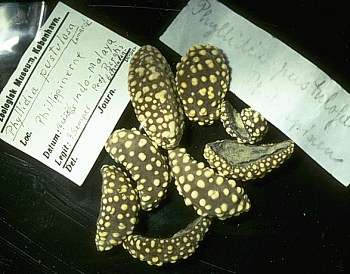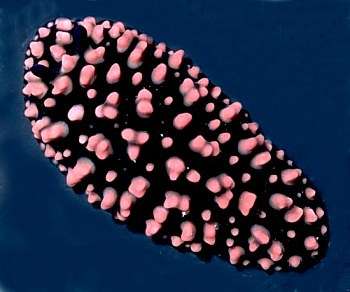

Phyllidiella nigra
(van Hasselt, 1824).
Order: NUDIBRANCHIA
Suborder: DORIDINA
Superfamily: EUDORIDOIDEA
Family: Phyllidiidae
DISTRIBUTION
Known from throughout the Indo-west Pacific region. It appears to be less common in the eastern Indian Ocean
PHOTO
Specimens examined by Bergh (1869) which he misidentified (as P. pustulosa), conserved in ZMUC (Brunckhorst, 1993; Plate 6A); Intertidal reef flat, Phi Phi Island, southern Thailand, 29 Nov. 1989, dorsal view of 40 mm specimen (Brunckhorst, 1993; Plate 6B).
Notes compiled from Brunckhorst, 1993:
Phyllidiella nigra is easily distinguished from conspecifics by its tall, rounded, dark pink to red tubercles which are evenly distributed (not clustered) over the dorsum. The bases of these tubercles are black.
Phyllidiella pustulosa and Phyllidiella annulata differ from P. nigra in the arrangement of the tubercles and in the number of lamellae on the rhinophoral clavus. Phyllidiella nigra is superficially similar to Phyllidiella cooraburrama , but the latter possesses fewer, very large multicompound, pale pink tubercles with broad, pale pink bases, and pale pink rims to the rhinophoral openings. Furthermore, P. cooraburrama possesses more lamellae (22-24) on the rhinophoral clavus (38-49 mm specimens).
Reference:
• Brunckhorst, D.J. (1993) The systematics and phylogeny of Phyllidiid Nudibranchs (Doridoidea). Records of the Australian Museum, Supplement 16: 1-107.
Rudman, W.B., 1999 (September 12) Phyllidiella nigra (van Hasselt, 1824).. [In] Sea Slug Forum. Australian Museum, Sydney. Available from http://www.seaslugforum.net/find/phylnigr
Related messages
Phyllidiella nigra mating
April 28, 2008
From: Kenneth Yong


Dear Bill,
My wife was going through some of our older photos to see if she could find feeding nudibranchs, and we came across this one of a pair of Phyllidiella nigra mating. I noticed that you seem not to have too many photos of this species. I must say that the only dive locality (so far) where I've found it to be almost abundant is Lang Tengah island off the coast of Terengganu, Malaysia. I've seen it in 6 inches of water among coral rubble and on a sandy bottom less than 10 feet from shore, where there're also huge aggregations of Plakobranchus ocellatus literally carpeting the bottom.
Locality: Lang Tengah Island, Blue Coral divesite, 5 m, Terengganu, Malaysia, South China Sea, 24 July 2006, Fringing coral reef. Length: 5-7 cm. Photographer: Kenneth Yong.
Once again, thank you so much for running what is by far my favorite website!
Cordially,
Kenneth
kyong67@tiscali.it
Yong, K., 2008 (Apr 28) Phyllidiella nigra mating. [Message in] Sea Slug Forum. Australian Museum, Sydney. Available from http://www.seaslugforum.net/find/20663
Thanks Kenneth,
and please thank your wife for looking for feeding photos! We don't have many photos of phyllidiids mating so any records are welcome. I am afraid identifying some phyllidiids just from photos is difficult so I have some doubts that this is Phyllidiella nigra, as its tubercles are almost all compound, or at least divided. In P. nigra they should be simple. It is possibly Phyllidiopsis burni, which has compound tubercles, but I am not sure. I'll leave it as P. nigra but only because I am not sure where else to put it. It is possibly just Phyllidiella pustulosa.
Best wishes,
Bill Rudman
Phyllidiella nigra from Sulawesi
December 23, 2002
From: Ginette Allard

Dear Bill,
Phyllidia or Phyllidiella? This photo is from the Bunaken area [NE Sulawesi, Indonesia] in July 2002. Photo: Frédéric André.
Thank you for your help,
Ginette Allard.
France
gigiallard@aol.com
Allard, G., 2002 (Dec 23) Phyllidiella nigra from Sulawesi. [Message in] Sea Slug Forum. Australian Museum, Sydney. Available from http://www.seaslugforum.net/find/8466Dear Ginette,
This is probably Phyllidiella nigra. There is a very similarly coloured species, Phyllidiopsis burni, but that differs in having a pale translucent edge to the mantle. As I can't see the edge clearly enough, the best I can do is guess.
Best wishes,
Bill Rudman
Phyllidiella nigra fromThailand
November 19, 2002
From: Sarawut Siriwong

Could you please identify this sea slug collected from the east coast of Thailand.
Thank you.
Sarawut Siriwong
siriwong_s@hotmail.com
Siriwong, S., 2002 (Nov 19) Phyllidiella nigra fromThailand. [Message in] Sea Slug Forum. Australian Museum, Sydney. Available from http://www.seaslugforum.net/find/8364Dear Sarawut Siriwong,
This is most probably Phyllidiella nigra. There is another species, Phyllidiopsis burni which also has scattered single tubercles on a black background, but in that species the tubercles are usually have multiple tips. In both species the tubercles are described as pink rayher than the blusih gray in your photo. I assume this is part of the normal colour variation found in quite a few species of phyllidiid, whoich often range from pink to green-gray in colour. Without more information on the external shape and colour, especially around the mantle edge, and the rhinophores, and the anatomy, I can't be totally sure of its identity. However I think Phyllidiella nigra is the most likely identity.
Best wishes,
Bill Rudman
Phyllidiella nigra
September 10, 1998
From: Aloysia Murni Shintosari


Are these Phyllidiella nigra (Hasselt, 1824). I concluded that it was Phyllidiella nigra based on the red tubercles on the notum and black rhinophore.
They are from the reef at Penjaliran Barat Island, Thousand Islands, Indonesia.
Thankyou for any advice
Aloysia
Aloysia Murni Shintosari
Museum Zoologicum Bogoriense
Cibinong, Indonesia.
mzb@indo.net.id
Aloysia Murni Shintosari, 1998 (Sep 10) Phyllidiella nigra. [Message in] Sea Slug Forum. Australian Museum, Sydney. Available from http://www.seaslugforum.net/find/236Correct again Aloysia. .. Bill Rudman.
